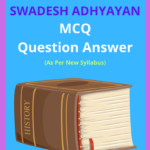Class 11 Swadesh Adhyayan Chapter 5 State and its Development, Class 11 Question Answer to each chapter is provided in the list of AHSEC so that you can easily browse through different chapters and select needs one. Class 11 Swadesh Adhyayan Chapter 5 State and its Development Question Answer can be of great value to excel in the examination.
Class 11 Swadesh Adhyayan Chapter 5 State and its Development Notes covers all the exercise questions in HS 1st Year Swadesh Adhyayan Textbooks Solutions. Assam Board Class 11 Swadesh Adhyayan Chapter 5 State and its Development provided here ensures a smooth and easy understanding of all the concepts. Understand the concepts behind every chapter and score well in the board exams.
State and its Development
Chapter – 5
SWADESH ADHYAYAN
1. (a) Who was the founder of the Varman dynasty.
Ans. Pushyamitra (Pushya Varman).
(b) Who among the Varman Kings established friendly relation with Harsha Vardhana?
Ans. Bhaskar Varman.
(c) During whose times did Hieun Tsang come to Assam.
Ans. Bhaskar varman.
(d) Which King transferred the capital of Kamprupa into Kamalpur?
Ans. Sandhya.
(e) Who translated the Ramayana Assamese first.
Ans. Madhav Kandoli.
(f) To which race did the Ahoms belongs?
Ans. Tai.
(g) Who said it is better to die Ahom to live in schoolardition to the Bengalis.
Ans. Chakradhvaj Sinha.
(h) Who translated the religious book “To the king’ into Sanskrit.
Ans. Vaskar Varman.
(i) Who was appointed to administrative the sadiya region.
Ans. Sadiya khowa Gohain was appointed to administrative of the sadiya region.
(j) Who was appointed the administer the region of present Golaghat to Dimapur?
Ans. Morangi Khowa Gohain.
2. Write a note on Geographical boundary of ancient Assam.
Ans. The assam that we have today is not a true representative of the geographical areas covered by ancient Kingdom of Kamrupa or pragjyotisha and therefore it is not possible to pressure. The sender of the letter from the central of the geographical boundaries of modern Assam. Even the royal documents do not provide clear ideas what is geographical boundaries of the kingdom in ancient time. Sources reveal that the kingdom of the ancient Kamrupa and pragjyotisha had a field boundary over time and the nature of it had failed to Give the kingdom of the Permanent boundary that extended over centuries. However what is certain is that of the pinnacle of the rise the submortane region and a portion of bhutan in the north had been port within the borders of Kamprupa and in the south west its boundary extended as for as to lower to some ports of present Bangladesh it is to lively that since at least the first and the second century AD the river Karalaya formed the western boundary of the kingdom.
The chinese buddhist Pilgrim Hiven Tsang crossing a big river lying (kerala) on the eastern frontier of pundravardhana (east bengal). These shows that the river karalayta still formed the western boundary of Kamrupa.an idea of the distinct geographical boundary of the kamarupa can be had from Chikali kamrupa composed during the pala kings around 10th century AD. The kalika purana states that the western boundary of kamrupa was karalaya and that time kingdom had a triangular shape. The length of the kingdom from karalaya to Dikkarvasana (Dhikrai) was a hundred yojana and breadth wasso yojyaya (1 yojona -15 miles). In cooporating modern guwahati and tezpur along with some territories on the east. The extend of the kingdom broundred towards the west.It is not known how for the measure of the kalika purana was correct. But the length of 30 yojpona might have meant the length of the median or that of the two equal baes of a angle. Thereafter the four hundred and fifty miles of area between krarlaya and dikrai comprisedthe kingdom of kamrup in the 10th century.
(3) Describe the role of the royal dynasties in the political rise and fall of ancient kimgdom of kamprupa.
Ans. There is no detect account of the position of assam. But a connected account of the political history of of the kingdom of kamprupa have been found since the second half of the fourth century AD . This kingdom sustained for about one thousand years to thirteenth years AD and within that penied the kingdom was ruled by three major houses.
(a) Varman Dynasty: The founder of the varman dynasty which rule since the middle of the fourth century AD WAS pUSHYA vARMAN tHIRTEEN KINGS OF THE dynasty ruled over kamrupa among them the most famous was the last king Kumar vhaskar Varman. During the dys of the varmans the kingdoms of kamprupa expanded towards like south and the west and included large areas of north-east and south-eastern part of bengal. The ruler of the Varman Dynasty came to an end by the middle of the seventh century AD and a powerful provincial ruler called statstambha look possession of the throne.
(b) Mlechcha Dynasty: Satastamsha a member of an aboriginal group called Mlechcha tiok possession after the varman dynasty . The capital of this kingdom was Dah Parbarya . The kingdom took on feudal characteristics with political power shaped between the king and samantas the last king of the stasstambha dynasty was Tyago Singha and after him Bramapala (akim) was selected for succession.
(c) Pala dynasty: There were eight King of the pala dynasty who reigned over thee kingdom.Ratnapala was the Brahmapala set the new capital at Sridurjaya and constructed many significant places there are the last king of the dynasty was dharmapala. DURING THE DAYS culture and literature flourished. The ancient Kingdom of kamrupa began the decline of the period after brahmapala..
4. What is the political condition of Assam in medieval times.
Ans. It is that the fragmented political duration before the medieval period was brought to an end by the Ahom. Before it the entire Brahmaputra valley got fragmented politically at the time of the decline of the kingdom of kamprupa. The komata kingdom that grew on the extreme westralise became devastated taking advantage of which the koch under the leadership of young and various Bishwa singha up the koch kingdom. Moreover the BHUYANS who emerged on the resources of the early kingdom of kamrupa, spread over different region of the kingdom and started ruling independently over the respective territories. On the southern bank of the valley, the kacharis established their kingdom in the region from present nagaon in the west is golaghat in the east.Contemporaneously the chutiyas also established their kingdom in the extreme east and north eastern region of the valley. It was during this time that the Ahoms laid the foundation of their kingdom in the south eastern part of the Brahmaputra Valley inhabitat by the Morans Borahis in the first half of the thirteenth century grew into an extensive sovereign state’ Assam” and from it emerged the modern state of Assam.
5. Discuss the established ment of the Ahom monarchy in the Brahmaputa Valley.
Ans. The entire Brahmaputra valley got fragmented politically at the time of the decline of the kingdom of kamarupa. The fragmented political situation was brought to an end by the ahom kingdom.
The ahoms were the descendants of the Shans of the tai race. Prior to their coming to Assam to Assam they were inhabitants of the state of Moo- lung, which tied in the area connecting nothern Burma an southern Yuman province of china choc lung sukapha, who led the ahoms in founding their kingdom in assam was a member of the Royal dynasty of Moolung and a claimant to the throne. Being deprived of the throne. Sukapha left Maslung in 1215 AD along with his family and a few trusted followers and set his foot on the Brahmaputra valley after crossing patkai hills of ahom-Burma Frontiers. Sukaphas was accompanied by very few companions and women were almost absent. On the other hand the route that sukaphalook was
predominantly inhabited by the Naga, Moran and Brohi tribes which made his journey extremely hazardous.
But Sukapha managed to established friendly relation with the moran and the brahmis, thereby made them superiors. Further by entering into material alliances, sukapha also established family relation with these tribes. This political of friendly relation aided sukapha much in establishing his kingdoms in ahoms. However, with certain tribes like the Nagas he had he had to resort to force and exchange arms to break through their stiff opposition. It is to be noted that to increase his strength and population sukapha embraced inti his fold almost all the tribes he came across and made them, members of the ahom community. Consequently though sukapha began his journey with few followers by the time he entered Assam to increase manifolding 1253 sukapha laid the foundation of the ahom kingdom by setting up his capital at charaides in the south – eastern corner of present undivided sibsagar district after long years of involvement in skirmishes. And alliances. Sukapha was followed by forty ruling kings resigning over a period of almost six hundred interrupted years. The establishment of the ahom monarchy in the brahmaputra valley is discussed above.
(i) Who was the writer of the Book “ Tobaquot – i- Nasiri”.
Ans. Minaj-uj-siraj.

Hi! my Name is Parimal Roy. I have completed my Bachelor’s degree in Philosophy (B.A.) from Silapathar General College. Currently, I am working as an HR Manager at Dev Library. It is a website that provides study materials for students from Class 3 to 12, including SCERT and NCERT notes. It also offers resources for BA, B.Com, B.Sc, and Computer Science, along with postgraduate notes. Besides study materials, the website has novels, eBooks, health and finance articles, biographies, quotes, and more.






